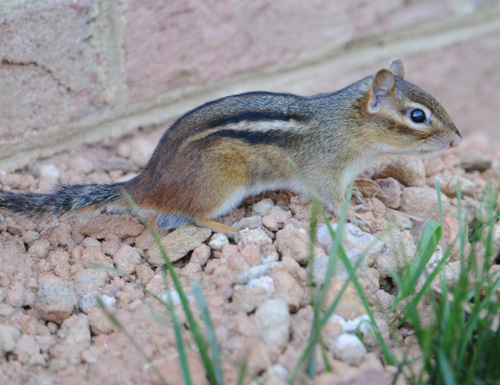Eastern chipmunks are very common in Connecticut. They have reddish brown fur above with one black stripe along their back and a white stripe bracketed by two black stripes on each side. There are two, small black stripes above and below each eye on their little faces. Their underside is white. Their 3 to 4 inch tails tend to be flat and furry and will have black and brown fur frosted with some white. They weigh 2 to 5 oz.
Eastern chipmunks range through the northeastern quarter of the US with some incursions further south, and up into southeastern Canada. They are active during the day in spring, summer and fall. Chipmunks dig burrows underground, usually one chipmunk inhabits one burrow. Here in Connecticut they are often burrowing in our numerous rock walls. Sometimes they dig where they damage garden plants, and they climb trees in search of food. In the winter they are dormant and stay in their underground dens. They'll wake every few weeks to eat from the stashed supply of food they diligently gathered in autumn. Sometimes on mild winter days a chipmunk may venture out briefly, but usually they stay snug in their den until spring.
Typical diet in the wild consists of tree nuts such as hickory nuts, beech nuts and acorns, seeds, some insects and some carrion. They can cause garden damage by eating seedlings, bulbs or fruits, but are not usually major pests. Their sheer cuteness often earns them forgiveness. Chipmunks have copious cheek pouches which they use for carrying food to their food caches in their burrows. A chipmunk under the birdfeeder often resembles a tiny, furry vacuum, stuffing in the fallen birdseed while its cheeks bulge ever-fatter. The pouches can expand to three times the size of their heads. These little rodents can store large amounts of food, sometimes as much as half a bushel in a large burrow chamber.
Most Eastern chipmunks mate in early spring, February to April, when they wake up from their winter napping. Litters are produced in May. In Connecticut there can be a second breeding period and subsequent litters in the summer months.
If you have heard a high-pitched, regular, "chip chip chip" call in the woods, it is likely you are hearing an alarmed chipmunk. The chipping can go on for a long time. This chip is so high-pitched it sounds like a birdcall, but it can be as regular as a metronome. Chipmunks make a lower-pitched "chuck" call and also a chip/whistle called a trill. All three calls are alarm signals. It is believed that the "chip" is made in response to danger on the ground while the "chuck" is in response to danger in the air, such as a raptor.
Neat Facts
Female chipmunks are receptive to breeding only for about 6 and a half hours, so male chipmunks have to be on their toes to win a bride.
Chipmunks have 4 toes on their front paws and 5 toes on their back paws.
